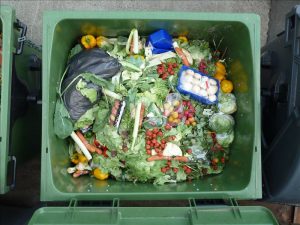The management of resources must surely take precedent in government policy and business strategy in the years ahead if we are to avoid muddled thinking and crowded bins, writes James Fitzgerald.
Many consumers may find it hard to swallow, but households are needlessly throwing away hundreds of tonnes of food each year, according to the European Commission (EC), which has just taken another step towards realising its goal of a “circular economy”.
MEPs last week voted to halve food waste in the European Union by 2030, by lifting existing restrictions on food donations and eliminating confusion about “best before” and “use by” labels.
“In developed countries food is wasted mostly at the end of the chain, at distribution and consumption. Everyone has a responsibility to tackle this problem,” said Biljana Borzan, a Croatian MEP who outlined the proposals. “My report calls for a co-ordinated policy response on labelling, liability and education, as most consumers do not understand the precise meaning of ‘best before’ and ‘use by’ labelling. Moreover, we should address the shortcomings of existing EU legislation where it hinders food donations,” she added.
Food waste is just one facet of the EU’s Circular Economy Package – “where the value of products, materials and resources is maintained in the economy for as long as possible, and the generation of waste minimised” – but it can, under some circumstances, be converted to energy.
#circulareconomy PT roadshow part II, showcasing companies working on the transition: Bordalo ii, Jular, @TheCoolFarm and @bookinloop pic.twitter.com/mEhvdPf86E
— Inês Costa (@eco_nomia_mamb) July 5, 2017
#Circulareconomy infographics credit: Plan—C
But what’s all the fuss about? Although environmentalists have been warning about finite resources amid growing populations for centuries, economists and marketeers now realise that urgent measures are needed to curb rising prices and volatility, which threaten to imperil global growth, human welfare and the environment.
According to the UN’s Food and Agriculture Organization, each year consumers in rich countries waste almost as much food (222m tonnes) as the entire net food production of sub-Saharan Africa (230m tonnes)
In the EU, food waste has been estimated at some 88m tonnes, or 173kg per capita per year. The production and disposal of this food waste leads to the emission of 170m tonnes of CO2 and consumes 26m tonnes of resources, according to the EC.
At the most basic level, discarded food means energy, water and land having been consumed to no avail. Then comes the complexity and expenditure involved in managing waste that could potentially have been avoided.
“Research confirms that about one third of annual food produced in the world for human consumption – approximately 1.3bn tonnes – gets lost or wasted,” said Jackie Nyaoro, an environmental consultant. “According to the UN’s Food and Agriculture Organization, each year consumers in rich countries waste almost as much food (222m tonnes) as the entire net food production of sub-Saharan Africa (230m tonnes).”
The McKinsey Global Institute predicts that up to three billion people could join the global ranks of the middle class over the next two decades, increasing demand for resources at a time when obtaining them could become more difficult and costly.
“The stress on the resource system is likely to be compounded by increasing links between resources that mean that price shocks in one can swiftly transmit to others. In addition, environmental deterioration, driven by higher consumption, is making the supply of resources – particularly food – more vulnerable,” said a McKinsey report from 2011.
But in the UK it is still more expensive to donate surplus food than to use it for energy recovery, according to an EC report.
Between 2010 and 2015, the UK-based non-profit organisation Wrap (Waste & Resources Action Programme) reduced CO2 emissions by nearly 50m tonnes, waste by 4m tonnes, water consumption by 856m cubic litres, and diverted 29m tonnes of waste from landfill. Wrap says it will concentrate on three key areas where resource management can make a difference: food and drink, clothing and textiles, electricals and electronics.
“According to Wrap, UK household food waste is running at about 7.3m tonnes annually. While we are right to target consumers, we should acknowledge that they are subject to very aggressive marketing by supermarkets and producers. We should be able to find a balance [between buying and consumption],” Ms Nyaoro told Chief-Exec.com.
She posits food wastage as a lifestyle issue, where the fast fashion mentality now pervades the food aisles. “Perhaps the key solution would be addressing the shorter shelf life. The other commonly accepted driver is the quality standards that over-emphasise appearance.”
Tristram Stuart, in his book Waste: Uncovering the Global Food Scandal, suggests that about 13,000 slices of bread are wasted daily by suppliers of sandwiches because of stipulations by Marks & Spencer that the end slices and the crusts of sandwich loaves should not be used. He also points out that one of the main suppliers to the supermarket chain ASDA rejects 25-30 per cent of carrots produced because they are the wrong shape or have blemishes. These rejects are channeled off for animal feed.
In the UK it is still more expensive to donate surplus food than to use it for energy recovery

Credit: Foerster/wikipedia
Retailers and producers will often discard food rather than offer it to charities or food banks for fear that they will be held accountable in the case of food poisoning or criticised for supplying inferior goods to the needy. Legislators could help shift these barriers by transferring responsibility from donors to recipients, as has happened in France, Greece and Italy. France and Spain now incentivise food donations through corporate tax credits.
The Findhorn community was founded in Scotland in 1962 with sustainability as a key precept. The Ecovillage in Moray is home to about 400 permanent residents and hosts various educational programmes that attract 3,000 visitors a year. The aim is to demonstrate the tangible aspects of spiritual values, as a complete lifestyle. The ecological houses use local materials, such as stone and straw bales, (some are recycled whisky vats) and the Ecovillage is powered by wind turbines.
The Living Machine sewerage system uses organic methods to process waste on site, but the efficiencies start long before that. “Much of our salads and vegetables are grown next door at Cullerne Gardens and at the start of the week the kitchen will inform the garden as to the guest number so that the appropriate amount of salads and vegetables can be harvested,” said Janet Limb, a spokesperson.
The community runs a veggie box scheme for the wider community which buys up surplus crops from local producers. “We buy locally grown organic food where possible to save wastage on food going off while it is being stored and then transported somewhere,” said Ms Limb. “Any leftover food is composted, including egg shells and tea bags.”
She says that “locally grown organic food tastes so much better and is more fulfilling to eat, so less food is wasted”.
The management of resources must surely take precedent in government policy and business strategy in the years ahead if we are to avoid muddled thinking and crowded bins. That could mean unwinding of tax incentives that keep prices artificially low and encourage inefficiencies, but also a pragmatic and independent approach to food by consumers, where local communities seek to cultivate crops locally where possible and maximise usage of existing supplies.
Today, the United Kingdom parliament published updates on Environmentally Sustainable Agriculture and Security of UK Food Supply.





